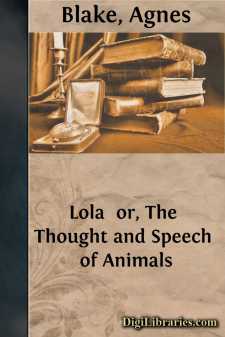Categories
- Antiques & Collectibles 13
- Architecture 36
- Art 48
- Bibles 22
- Biography & Autobiography 813
- Body, Mind & Spirit 142
- Business & Economics 28
- Children's Books 15
- Children's Fiction 12
- Computers 4
- Cooking 94
- Crafts & Hobbies 4
- Drama 346
- Education 46
- Family & Relationships 57
- Fiction 11828
- Games 19
- Gardening 17
- Health & Fitness 34
- History 1377
- House & Home 1
- Humor 147
- Juvenile Fiction 1873
- Juvenile Nonfiction 202
- Language Arts & Disciplines 88
- Law 16
- Literary Collections 686
- Literary Criticism 179
- Mathematics 13
- Medical 41
- Music 40
- Nature 179
- Non-Classifiable 1768
- Performing Arts 7
- Periodicals 1453
- Philosophy 64
- Photography 2
- Poetry 896
- Political Science 203
- Psychology 42
- Reference 154
- Religion 513
- Science 126
- Self-Help 84
- Social Science 81
- Sports & Recreation 34
- Study Aids 3
- Technology & Engineering 59
- Transportation 23
- Travel 463
- True Crime 29
Lola or, The Thought and Speech of Animals
by: Agnes Blake
Categories:
Description:
Excerpt
THOUGHT CAPACITY IN ANIMALS
It was in the year 1904 that the first experiments towards understanding an animal's ability to think were brought into public light. Wilhelm von Osten then introduced his stallion Hans II to all who seemed interested in the subject, and the most diametrically opposed opinions were soon rife with regard to the abilities of this horse, to which von Osten maintained he had succeeded in teaching both spelling and arithmetic.
The animal's mental activity was said to lie in a simple form of thinking, called into being and intensified by means of a certain amount of instruction. Von Osten, who had been a schoolmaster, had previously spent some fourteen years in testing the intelligence of two other horses before he ventured to make his experiences public, and the performances of these animals were not only remarkable, but of far-reaching importance.
Hans I, aged twelve, died in 1905. He had never appeared in public, since his abilities had been relatively modest. He had, nevertheless, been able to count up to five, as well as carry out quite a number of verbal instructions. It was Hans II, however, that convinced his master—as early as 1902—of his ability to comprehend a far greater range of the German alphabet (when written), as well as to recognize a certain number of colours.
Instances, denoting signs of evident reflection and memory, had led to Wilhelm von Osten turning his thoughts towards this work of animal tuition. Public opinion was divided; there were some who took the subject seriously and who were grateful to this innovator for thus opening a new path of inquiry; yet many were sceptical—and the scientific commission called together in 1904 to investigate the subject, finally knew no better than to heap their ridicule on the careful and patient labours of a lifetime. "Der kluge Hans" ("wise" or "clever Hans")—by that time already a public character—now evoked supercilious smiles and stood disgraced in the eyes of the majority. Only a few, capable of delving more deeply into the subject, continued to follow these performances with ever-increasing interest and amazement and kept their faith whole.
Von Osten—though now embittered and pathetically silent—quietly continued his experiments up to his death, which took place in 1909. At first he had gone about his work alone, but he was joined subsequently by Karl Krall, who then became known in connexion with this work for the first time.
Many were the attempts made in certain quarters of the Press to account for the facts of the case; the very simple means of procedure employed by von Osten were scouted and the whole thing proclaimed to be based upon trickery, influence, secret signs, an abnormal degree of training, and what not—anything and everything was seized upon in order to come into line with ordinary opinion.
Then, in the year 1905, Karl Krall, of Elberfeld, began his experiments with Hans II, encouraging, as a foundation for the furtherance of his theories, the abilities already developed in this horse, while devoting a more profound measure of insight to the entire problem....


